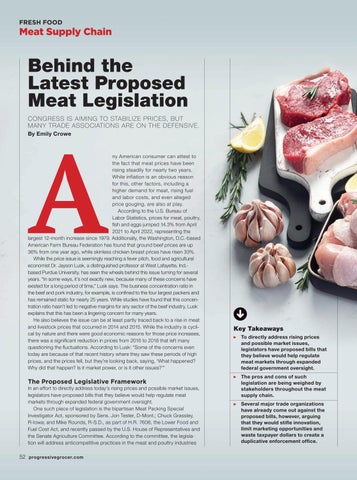FRESH FOOD
Meat Supply Chain
Behind the Latest Proposed Meat Legislation CONGRESS IS AIMING TO STABILIZE PRICES, BUT MANY TR ADE ASSOCIATIONS ARE ON THE DEFENSIVE. By Emily Crowe
ny American consumer can attest to the fact that meat prices have been rising steadily for nearly two years. While inflation is an obvious reason for this, other factors, including a higher demand for meat, rising fuel and labor costs, and even alleged price gouging, are also at play. According to the U.S. Bureau of Labor Statistics, prices for meat, poultry, fish and eggs jumped 14.3% from April 2021 to April 2022, representing the largest 12-month increase since 1979. Additionally, the Washington, D.C.-based American Farm Bureau Federation has found that ground beef prices are up 36% from one year ago, while skinless chicken breast prices have risen 33%. While the price issue is seemingly reaching a fever pitch, food and agricultural economist Dr. Jayson Lusk, a distinguished professor at West Lafayette, Ind.based Purdue University, has seen the wheels behind this issue turning for several years. “In some ways, it’s not exactly new, because many of these concerns have existed for a long period of time,” Lusk says. The business concentration ratio in the beef and pork industry, for example, is confined to the four largest packers and has remained static for nearly 25 years. While studies have found that this concentration ratio hasn’t led to negative margins for any sector of the beef industry, Lusk explains that this has been a lingering concern for many years. He also believes the issue can be at least partly traced back to a rise in meat and livestock prices that occurred in 2014 and 2015. While the industry is cyclical by nature and there were good economic reasons for those price increases, there was a significant reduction in prices from 2016 to 2018 that left many questioning the fluctuations. According to Lusk: “Some of the concerns even today are because of that recent history where they saw these periods of high prices, and the prices fell, but they’re looking back, saying, ‘What happened? Why did that happen? Is it market power, or is it other issues?’”
The Proposed Legislative Framework
In an effort to directly address today’s rising prices and possible market issues, legislators have proposed bills that they believe would help regulate meat markets through expanded federal government oversight. One such piece of legislation is the bipartisan Meat Packing Special Investigator Act, sponsored by Sens. Jon Tester, D-Mont.; Chuck Grassley, R-Iowa; and Mike Rounds, R-S.D., as part of H.R. 7606, the Lower Food and Fuel Cost Act, and recently passed by the U.S. House of Representatives and the Senate Agriculture Committee. According to the committee, the legislation will address anticompetitive practices in the meat and poultry industries
52
progressivegrocer.com
Key Takeaways To directly address rising prices and possible market issues, legislators have proposed bills that they believe would help regulate meat markets through expanded federal government oversight. The pros and cons of such legislation are being weighed by stakeholders throughout the meat supply chain. Several major trade organizations have already come out against the proposed bills, however, arguing that they would stifle innovation, limit marketing opportunities and waste taxpayer dollars to create a duplicative enforcement office.













